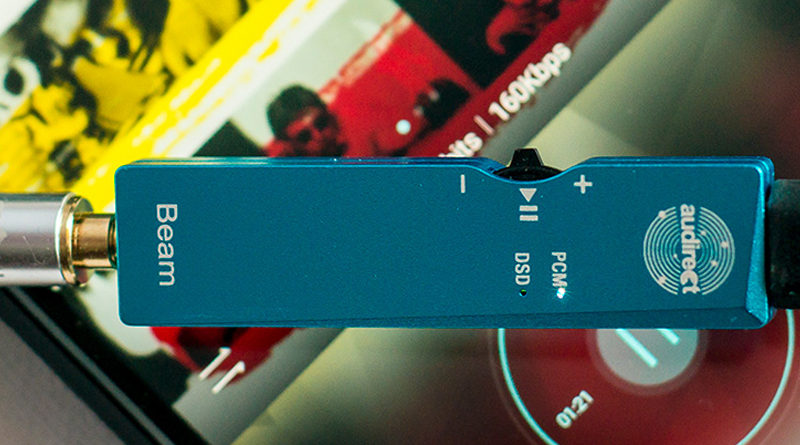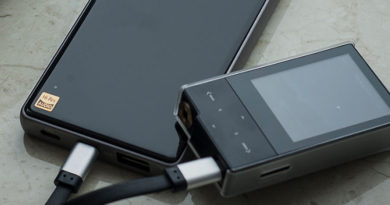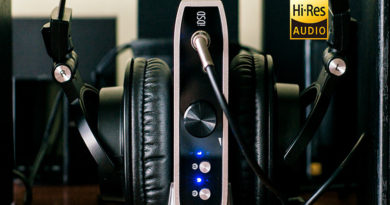AUDIRECT BEAM — ultra-portable USB DAC to pump your sound


Finally there is something else rather than IEMs to talk about. IEMs are good piece of technology but some rest is required while running out of words to describe the next pair. Today we would jump to another trending stuff — external ultra-portable DAC& which purpose is to pump the sound quality of a smartphone, laptop or tablet. But not only that — it can also turn back the time and equip your device with beloved warm, tube-like analog 3.5mm audio jack, if you’ve happened to miss that one!
The topic of our review today is AUDIRECT BEAM ultra-portable USB DAC& — this is the second product of this type in AUDIRECT lineup after Whistle DAC. This brand has 5 years experience in R&D of different video-audio appliance, mostly known for their successful HDX1000 and BD1 mediaplayers. Now they have decided to turn their sight at ultra-portable DACs due to the latest trend of many popular smartphone makers to abandon 3.5mm audio jacks (which is sad, but true). The idea is not new, but why not having one more option to bring 3.5mm back…

AUDIRECT BEAM is available for purchase at PenonAudio store
AUDIRECT BEAM technical specifications:
- Output Power:
- -114dB TND+N, 2Vrms | 600Ω
- -108dB THD+N, 49mW | 32Ω 1.1Vrms, up to 1.1Vrms
- Frequency response: 20-30000Hz (-0.15dB)
- Distortion: 0.0004%
- S/N ratio: +125dB SNR, +120dB DNR
- Input supports PCM: PCM 16-32bit/32-384KHz
- Input supports DSD: DoP64/128, Native DSD64/128/256
- DAC Chip: ES9118 SABRE HiFi SoC
- AMP Chip: ES9118
- I.R.: <1Ω
- Inputs: USB-C
- Outputs: 3.5mm
- Dimensions: LxWxH: 52x14x6mm
- Weight: 12g
UPDATE: just got to know that AUDIRECT BEAM has passed HiRES certification (JAS) and now would have HiRES sticker on it.
ES9118 DAC chip belongs to SABRE HIFI grade SoC which integrates DAC with a proprietary ESS headphone amplifier and output switch. Some additional infromation from the official website:
«ES9118 HiFi SoC leverages the company’s patented 32-bit HyperStream architecture to deliver up to 125 dB SNR and -112 dB Total Harmonic Distortion plus Noise (THD+N) ensuring audiophile quality sound all the way to the headphones. It also supports the industry’s most popular high resolution and lossless audio formats including FLAC, ALAC, AIFF and WAV»

Among other features there are (from official statements):
- Enough power to drive up to 300Ω earphones
- Physical jog dial with volume +|- and PLAY|PAUSE funсtions
- OFC, silver-coated copper wires
- No battery inside, power over USB
- Compatible with iOS/Mac/Win10/Android operation system
Packaging, build quality and design:
Didn’t expect to see such a small device in a such a large box.

Anyway, it is neat and stiff enough to protect all the contents. AUDIRECT logo at the front and BEAM description at the back. Accessories are packed in a separate box.

Box contents:
- BEAM DAC
- microUSB typeC -> USB adapter cable
- microUSB typeC -> microUSB typeC adapter cable
- microUSB typeC -> Lightning adapter cable

Kind of embarassing that there is no microUSB typeC -> microUSB cable included… Just another adapter but covering much more smartphones, potentially. We understand that most of the smartphones running Android OS with no 3.5mm audio output are already equipped with USB typeC port but it doesn’t mean that this DAC won’t be used to upgrade the sound quality even if there is one… Come on, AUDIRECT, make everyone happy and don’t create artificial limitations to various usage scenarios!

This little DAC is made of 2 pieces of aluminum — top and bottom covers with four screws holding the whole structure as one piece. Quality of shell crafting is decent. Parts are perfectly aligned. All labels and indicators are neat.

There are two small LEDs located at the front to indicate current stream type (PCM or DSD). Spring loaded VOLUME up|down dial is combined with PLAY|PAUSE function and located on the left edge. Button is convenient to use and have a good grip. Top edge has microUSB typeC input and bottom edge contains only 3.5mm audio output. No other elements and controls.

BEAM doesn’t have the battery inside and totally power-dependent of the source device. We’d say that this is more proper way rather than having another device that should be charged independently and would have more weight.
Usage scenarios:

We think that this device would be useful in the next scenarios:
- Adding 3.5mm audio output to a smartphone|laptop|tablet if there isn’t one
Scenario 1 is obvious — if there is not 3.5mm output and you have good headphones with 3.5mm jack BEAM would be a good choice in terms of sound quality characteristics. No doubt that there are other ultra-portable DACs available to solve the same issue but BEAM is another good option.
2. Upgrading sound quality of a smartphone|laptop|tablet not regarding whether there is native 3.5mm audio output or not.
This implies that you are not satisfied with the audio quality of your device or|and that is BEAM is surerior in this respect. There are some capable smarphones out there nowadays that would be directly competing, but only few. Same goes for the laptops. Tablets are usually left aside when it comes to audio quality — good that they can play sound at all In our case it is Xiaomi Redmi Note 4X smartphone with low power&low quality sound processing and Lenovo Y500 laptop with regular integrated IntelHD sound card. So, we would opt to use external USB DAC based on more capable DAC& chips to increase the audio quality.

3. Adding some juice when driving higher loads (headphones with higher impedance)
Scenario 3 is the addition to either scenario 1 or 2. Headphones with higher impedance would require more output power from a device to be driven to a better sound quality level in terms of dynamics, amplitude, volume, etc. Regular smartphones or tablets would usually give out ~30mW power while BEAM is capable of ~50mW @ 32Ω resulting in more volume and more driving ability. We doubt that this power would be appropriate for 300Ω loads but something up to 80Ω should do.
4. Adding 32bit/384kHz and DSD/native DSD playback to a device
Another addition to the previous ones but in terms of source device compatibility with various audio formats. Passing the stream to modern external DAC would remove some source limitations and allow you to listen to more sophisticated formats. For example, Xiaomi Redmi Note 4X doesn’t want to eat DSD files unless you would connect external USB DAC. But even if it did — it would still be DSD over PCM and not DSD native.
Getting it to work:
AUDIRECT BEAM is a user-friendly device. Using it under Windows 10/MAC OS/iOS and Android is straight forward — just connect and it would be recognized by the system. In case of Windows 10 it should be hiliDAC (HS) . If Windows10 has not recognized this device or if you are still running Windows 7/8 there is an additional driver which can be found HERE. This driver seems to belong to ASIO family which is even better than system Windows10 driver but would result in larger audio lag. The next step in Windows environment would be going to recognized device options and selecting the maximum desired audio quality (right click on volume icon in tray -> sounds -> playback devices tab -> select the device -> properties -> additional -> select 24/32bit, 192/384kHz -> ok). Run some music player like Foobar2000 and pass the stream over WASAPI (push) or ASIO to BEAM DAC. No problems in our case.

Using it with Android is even easier — just connect BEAM and run some audio player like HibyMusic. You can also set HibyMusic to use external DAC in «Exclusive HQ Audio mode» to get bit-perfect stream.
Can’t tell anything about iOS or MAC OS — we don’t have any APPLE devices to test BEAM with.
Sound quality:
Tested with Xiaomi Redmi Note 4X, Lenovo Y500, Anew U1 IEMs
Connected to smartphone:
The differences in sound quality between bare 3.5mm audio output of Xiaomi smartphone and BEAM are apparent: better presence and bass extension, more powerful and full-bodied midbass, crispier and brighter treble together with better extension as well. Some of those differences are the result of better driving ability while others are due to more capable DAC/AMP SoC. Native smartphone audio output sounds thin, parts of the midbass dynamics is totally lost, deep bass sounds blurry and the treble is far too simple and limited. Therefore, concerning that BEAM is a little and lightweight device that doesn’t require charging — it is a good option for a smartphone to upgrade SQ and add the ability to play more formats even while on the go.

Connected to laptop:
Almost the same differences in sound here, although less emphasized. Laptop audio output is more powerful and can produce some good midbass dynamics with better extension of lower end but the crispness and extension of treble as well as overall resolution are still better when passing music through BEAM. Using ASIO instead of WASAPI should be capable of even better results but we would sacrifice that in favor of less audio lag which is vital while watching video content.
Compared to Hidizs SONATA HD DAC cable:

Hidizs Sonata HD cable is very similar device purpose-wise but very different in terms of design approach. It is even smaller, doesn’t have any controls or indicators and is not that capable when it comes to DSD or maximized bit depth. There are some major sound differences when compared to BEAM: Sonata can reach deeper bass levels but with less texturing, it emphasizes treble more and elevates upper mids. Moreover, lower mids are a bit thin and underpowered resulting in more apparent U-shaped tuning. It definitely has a brighter tonality and bit more power to drive higher loads. More prone to hissing, though. BEAM sounds more natural and balanced, with more even distribution of gains on lower and treble ranges. Midbass is rich and powerfull on both devices.

Conclusion:
In our case AUDIRECT BEAM served its purpose very well. It is a clear win over intergrated audio interfaces in our smartphone|laptop and really managed to increase its sound quality with a better driving ability and more capable DAC element base. Of course, it wouldn’t be much of revelation but is able to normalize frequency gain levels, increase instrument separation and add more resolution. Sound is fairly balanced and detailed to provide good listening experience while at home or on the go. It also did provide our smartphone with the ability to play more advanced audio formats like DSD (native) together with higher bit depth and sampling frequencies of FLAC files. Furthermore, BEAM is user-friendy, doesn’t require charging, has the convenient formfactor to be carried and used in a pocket, free of software and hardware issues. Consequently, all minor and major characteristics of AUDIRECT BEAM are looking implemented right as expected and this little device could be recommended for anyone who wants some more juice and quality of sound or simply misses 3.5mm audio output.




